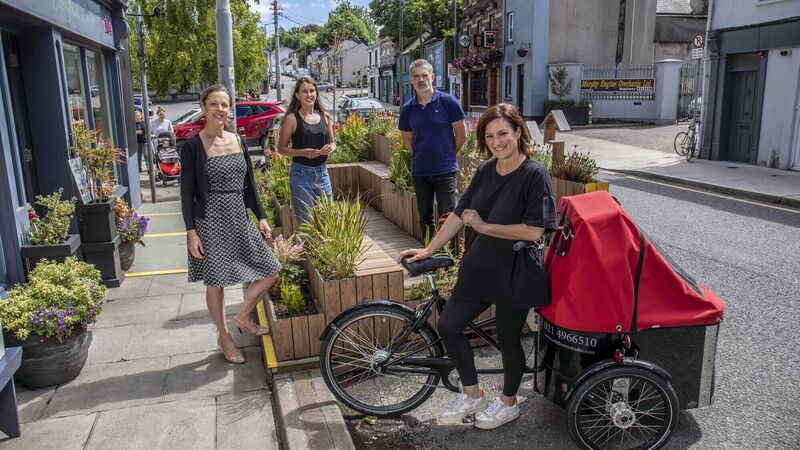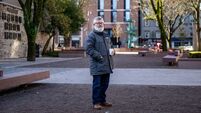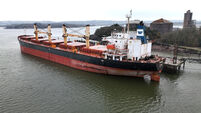Michael Moynihan: We need to make urban access for the elderly a priority in Cork

The parklet on Douglas St, Cork. more and better benches in the city would make it a more attractive destination for the mother or father bringing a small child into town, writes our columnist. Picture: Clare Keogh
THE reason we went down to Blackpool for chips that evening is long gone, which isn’t surprising: the event took place around 1979.
But not all of the experience is lost forever.
Whatever the cause of the nighttime adventure — consoling someone because they’d lost a match, or a tooth, maybe — it was dark when my late father nosed the car out onto Dublin Hill, where he caught sight of an elderly neighbour at his front door.
He rolled down the window for a chat and a minute later the neighbour was in the front seat of the car, rolling down the hill with us for our battered sausages and whatnot.
Even a Blackpool loyalist as staunch as myself would concede that the main drag by Dan Lyons’ bar and the old Pantry in the late ‘70s would never be mistaken for the Strip in Las Vegas at its dazzling best, but our neighbour practically had his nose to the windscreen, taking in the sights and sounds.
After we collected our food and zoomed back up the hill he got out and thanked my father for the spin, adding: “It must be 20 years since I was in town at night.”
Brief though it was, I’ve always remembered that exchange, and it came to mind when someone made a very valid point to me a week or two ago — they pointed out that while in previous columns I had called for the city to be more child-friendly, what about those at the other end of the age spectrum?
How accessible is Cork for the elderly?
Is the city you take for granted a welcoming zone for its older residents?
One obvious starting point is to conflate the two categories mentioned above, because if an urban space is welcoming to small children then it’s welcoming to all, including those who may have reduced mobility.
With that in mind, I visited 880cities.org, the website of a Canadian organisation which puts that idea clearly: “We exist to create safe and happy cities that prioritise people’s wellbeing.
“We believe that if everything we do in our public spaces is great for an eight-year-old and an 80-year-old, then it will be great for all people.”
The organisation’s founder and chair, Gil Penalosa, has spoken in interviews about what that means in theory, saying, “We have to stop building cities as if everyone is 30 years old and athletic.”
A good starting point: I’ve written here in the past about most cities, not just Cork, being designed for men, with all that that means for women’s safety, but clearly even that description needs to be finessed — they’re designed for young athletic men, to be precise.
Penalosa has an interesting thought experiment for people to help them evaluate their city — he invites people to imagine a busy intersection in their city and ask whether it’s suitable for people to cross there.
That means all people, not just that mythical, athletic 30-year-old for whom the city is an adventure playground.
Challenges
Think of the small child or elderly resident who may find narrow footpaths and new bicycle lanes a challenge, who may be nervous about their chances of getting across a wide street before the red man flashes on the traffic lights.
In that context it was interesting in recent days to see people posting on social media about a relatively new phenomenon in Cork, where the red signal at a traffic light seems to have become an opening gambit in negotiations rather than a command to stop.
The number of cars and bikes which now take it as their due to roll through red lights at intersections such as Albert Quay (at both ends) and Parliament St coming onto the South Mall makes crossing those streets a gamble for all pedestrians.
Penalosa has articulated the wider context for taking care to accommodate all of a city’s citizens. In an interview with AARP.org he said: “Clean, attractive places to walk dignify pedestrians so they don’t feel like second-class citizens. Everybody walks and every trip starts on foot.
“Start by lowering traffic speeds, giving walkers a five-second head start at traffic lights and building crosswalks with ‘safety islands’ in the middle of the street.
“We need to have good benches added to the streets so older adults can walk further by being able to take breaks along the way."
People will walk if they know that when they get tired, they can sit for a while and watch the world go past.
This is obvious, of course, but how many parts of Cork can you honestly describe as being designed to facilitate the older adult, to make their experience of the city a better one?
It goes without saying that more and better benches in the city would also make it a more
attractive destination for the mother or father bringing a small child into town — hence the eight to 80 mantra.
Penalosa also stressed the importance of city parks for the older cohort of the population — when managing the public parks of Bogota in Colombia he said: “We trained older adults to run activities for other older adults.
We’d have a ceremony and give them a diploma — and they would dress in their best clothes and bring the family.
Then they would go to work doing everything from organizing bingo games to starting bands and orchestras of older adults.”
Practical steps
“We cut back all the tree branches that were lower than six feet, so no one could jump out of the foliage . . . we installed proper lighting in parks and public spaces . . . we hosted events that attracted all kinds of people. We invited The Three Tenors — Placido Domingo, José Carreras and Luciano Pavarotti — to perform because it brought different people to the park, people who were then surprised by how beautiful and safe and clean it was.”
Before anyone starts sniggering about people jumping down out of the trees in Colombian parks, it might be better to ask yourself how safe you feel in some of our own parks here in Cork — no matter what age you are.
That’s if you can even access them in the first place, of course. Not far from where I write there’s a large park which has two entrances — one from a narrow street, the Ballinlough Road, and the other from a far wider road, the Boreenmanna Road.
Accessing the park for anyone, young or old, is a breeze from the Ballinlough Road side; access from the far side of the Boreenmanna Road, particularly at school pick-up and drop-off time, is a far greater challenge.
As always, it’s interesting to see how looking at a specific issue — urban access for the elderly — quickly pulls in others which are adjacent to it (transport, infrastructure, leisure, children’s access).
That doesn’t negate the focus on the initial issue, however, and this is a subject I’ll return to in a future column.
After all, it’s been brewing in my mind since 1979.
CONNECT WITH US TODAY
Be the first to know the latest news and updates











